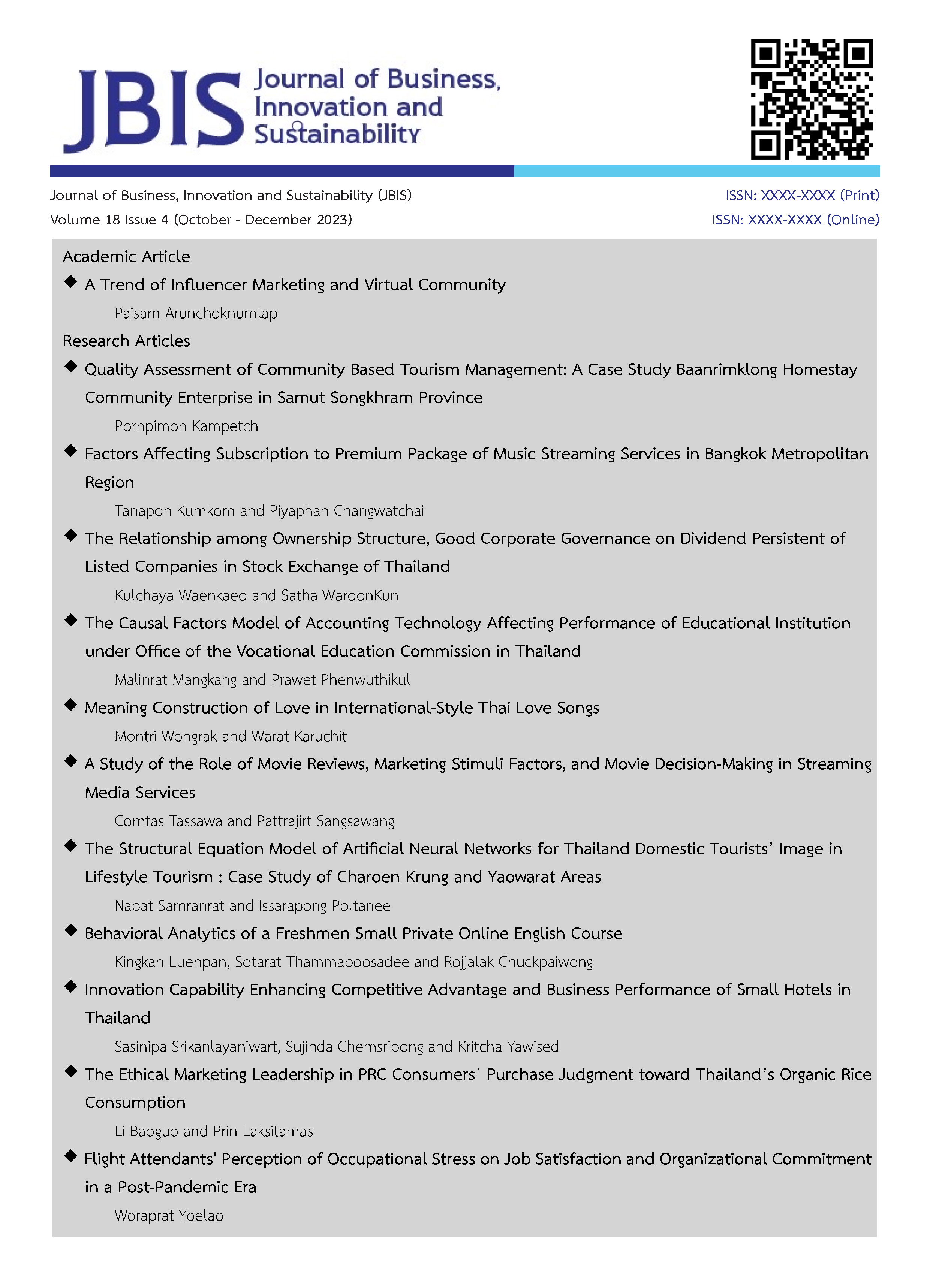Meaning Construction of Love in International-Style Thai Love Songs
Main Article Content
Abstract
This qualitative research aimed to study the construction of the meaning of love in international-style Thai love songs, the love representation that appears in the songs, and the construction process of the meaning image of the songwriters. Forty popular international-style Thai love songs were analyzed, and the sender was studied through in-depth interviews of the eight purposively selected songwriters. The results revealed that the image of love in love songs could be divided into seven types: ideal love, passionate love, fascinated love, conditional love, expected love, unrequited love, and empty love. The construction process of the love images included two stages: 1) the stage of perceiving meaning, in which songwriters learn from society and experiences, and 2) the stage of conveying meaning, in which songwriters encode accumulated knowledge to convey the meaning based on their perspectives. The encoded and decoded meaning resulted from decoding the world of reality. As the meaning has a tendency to change over time, the image of love can reflect the zeitgeist of a particular era.
Article Details

This work is licensed under a Creative Commons Attribution-NonCommercial-NoDerivatives 4.0 International License.
References
Bandura, A. (1986). Social foundations of thought and action: A social cognitive theory. New Jersey: Prentice-Hall.
Berger, P. and Luckmann, T. (1966). The social construction of reality: A treatise in the sociology of knowledge. New York: Anchor.
Boring, E. (1950). A history of experimental psychology (2nd ed.). New York: Appleton Century- Crofts.
Erikson, E. (1968). Identity: Youth and crisis. New York: W. W. Norton & Company.
Friedlander, P. (1996). Competency-driven, component-based curriculum architecture. Nonprofit Management Leadership, 35(2), 14-21.
Fromm, E. (1975). The art of loving. London: Unwin.
Gallée, J. and Levitt, A. (2016). Are love songs lyrically gendered? A content analysis of gender-specific speech features in song lyrics. Retrieved August 12, 2022 from https://repository.wellesley.edu/object/ir696
Gomutmass, S. (1999). Analysis of music literature of Rewat Buddhinan. Master Thesis, M. A., Ramkhamhaeng University, Bangkok.
Hall, S. (1997). Representation: Cultural representations and signifying practices. London: Sage.
Hofstede, G. (1980). Culture’s consequences: International differences in work-related values. London: Sage.
Homtoopprom, P. (2011). Themes, content and lyric/tune formats of Thai classical love songs from 1932-87. Master Thesis, M.A., Sukhothai Thammathirat University, Bangkok.
Kheovichai, K. (1991). Principles of recreation. Nakhon Pathom: Silpakorn University.
Lee, J. (1973). The colors of love: An exploration of the ways of loving. Toronto: New Press.
Leesomboonphol, P. (2006). A string song with lyrics about love in an immoral manner that were published between 2003 and 2004. Research Report, Muban Chombueng Rajabhat University, Ratchaburi.
Littlejohn, S. W. (1988). Theory of human communication (3rd ed.). Belmont: Wadsworth.
Panichlocharoen, V. (2000). The social construction of reality concerning love relationship patterns in postmodern society of Thai popular music video. Master thesis, M.Comm., Chulalongkorn University, Bangkok.
Promarach, N. (2017). Sign usage in the meaning of love between man and woman in Thai music videos. Master thesis, M.A., Chaing Mai University, Chaing Mai.
Puohiniemi, M. and Verkasalo, M. (2020). Zeitgeist effects, fragmentation of media use, and value consensus. Journal of Social and Political Psychology, 8(1), 300-332.
Raksatman, S. (2004). Young people and the social construction of love in Thai popular music. Master thesis, M.A., Thammasat University, Bangkok.
Rogers, J. (2017). A history of love song in 10 tracks. Retrieved August 12, 2022 from https://www.theguardian.com/music/2017/feb/12/a-history-in-10-love-songs-serge-gainsbourg-magnetic-fields-antony-johnsons-one-direction
Samma, A. (2003). An analysis of lyrics of popular international Thai songs among Thai teenagers (B.E. 2545). Research Report, Songkhla Rajabhat University, SongKhla.
Sriprapandh, K. (2008). Representation of poor people in TV game. Ph.D. Thesis, Ph.D., Thammasat University, Bangkok.
Sternberg, R. (1986). A triangle theory of love. Psychological Review, 93(2),119-135.
Tinsulanon, J. (2010). The form and communicative strategy in Thai popular song lyrics by Surak Suksaewee. Master thesis, M.A., Mahidol University. Bangkok.
Watson, R. and Evans, R. (1991). The great psychologists: A history of psychological thought (5th ed.). New York: HarperCollins.
Winit, P. (1999). Forms and characteristics of language use in popular music literature. Master Thesis, M.Ed., Mahasarakham University, Mahasarakham.
YaiKhum, J. (2004). Thai way of life from the Thai style’s countries song. Master Thesis, M.A., Ramkhamhaeng University, Bangkok.


